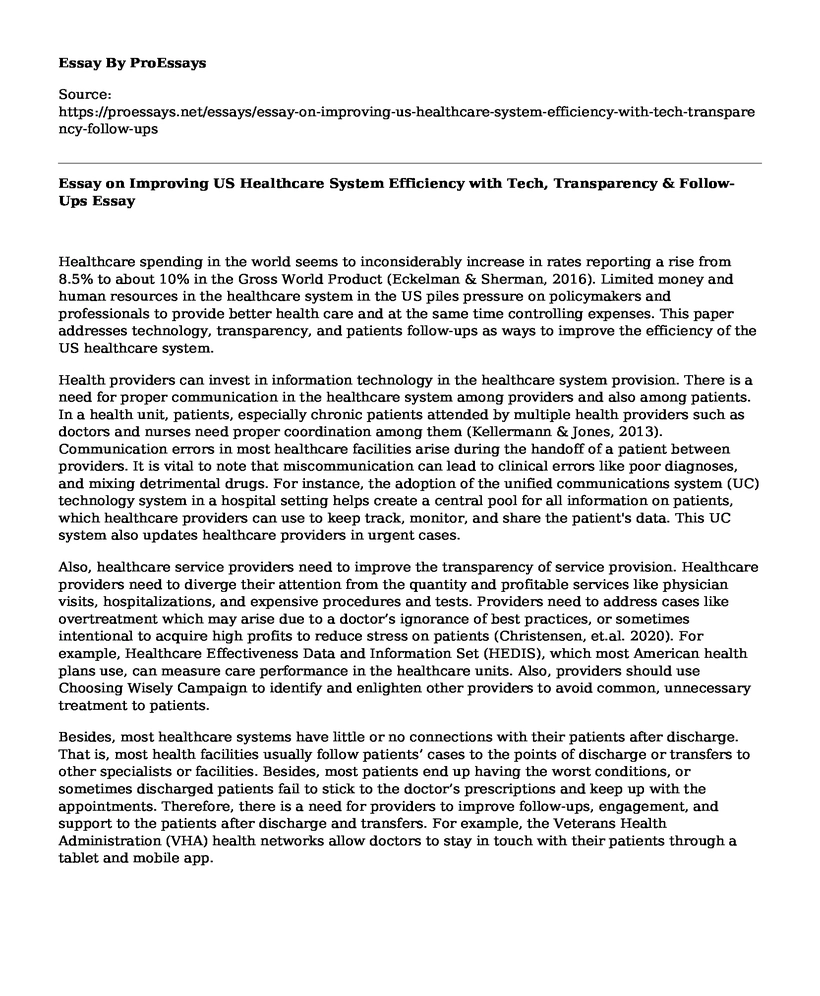Healthcare spending in the world seems to inconsiderably increase in rates reporting a rise from 8.5% to about 10% in the Gross World Product (Eckelman & Sherman, 2016). Limited money and human resources in the healthcare system in the US piles pressure on policymakers and professionals to provide better health care and at the same time controlling expenses. This paper addresses technology, transparency, and patients follow-ups as ways to improve the efficiency of the US healthcare system.
Health providers can invest in information technology in the healthcare system provision. There is a need for proper communication in the healthcare system among providers and also among patients. In a health unit, patients, especially chronic patients attended by multiple health providers such as doctors and nurses need proper coordination among them (Kellermann & Jones, 2013). Communication errors in most healthcare facilities arise during the handoff of a patient between providers. It is vital to note that miscommunication can lead to clinical errors like poor diagnoses, and mixing detrimental drugs. For instance, the adoption of the unified communications system (UC) technology system in a hospital setting helps create a central pool for all information on patients, which healthcare providers can use to keep track, monitor, and share the patient's data. This UC system also updates healthcare providers in urgent cases.
Also, healthcare service providers need to improve the transparency of service provision. Healthcare providers need to diverge their attention from the quantity and profitable services like physician visits, hospitalizations, and expensive procedures and tests. Providers need to address cases like overtreatment which may arise due to a doctor’s ignorance of best practices, or sometimes intentional to acquire high profits to reduce stress on patients (Christensen, et.al. 2020). For example, Healthcare Effectiveness Data and Information Set (HEDIS), which most American health plans use, can measure care performance in the healthcare units. Also, providers should use Choosing Wisely Campaign to identify and enlighten other providers to avoid common, unnecessary treatment to patients.
Besides, most healthcare systems have little or no connections with their patients after discharge. That is, most health facilities usually follow patients’ cases to the points of discharge or transfers to other specialists or facilities. Besides, most patients end up having the worst conditions, or sometimes discharged patients fail to stick to the doctor’s prescriptions and keep up with the appointments. Therefore, there is a need for providers to improve follow-ups, engagement, and support to the patients after discharge and transfers. For example, the Veterans Health Administration (VHA) health networks allow doctors to stay in touch with their patients through a tablet and mobile app.
Conclusion
In summary, healthcare units need to invest in automation tools and communication technology to reduce operational costs, minimize clinical blunders, and improve service provision to patients. Likewise, health policymakers need to provide a clear pathway for patients in their service provisions. Additionally, individual professionals need to stay connected with their patients after discharge to ensure complete treatment of the patients. However, there are other ways that policymakers and professionals can use to improve the healthcare system.
References
Eckelman, M. J., & Sherman, J. (2016). Environmental impacts of the US health care system and effects on public health. PloS one, 11(6), e0157014. https://journals.plos.org/plosone/article%3Fid%3D10.1371/journal.pone.0157014
Kellermann, A. L., & Jones, S. S. (2013). What it will take to achieve the as-yet-unfulfilled promises of health information technology. Health affairs, 32(1), 63-68. https://www.healthaffairs.org/doi/full/10.1377/hlthaff.2012.0693
Christensen, H. B., Floyd, E., & Maffett, M. (2020). The only prescription is transparency: The effect of charge-price-transparency regulation on healthcare prices. Management Science. https://www.tse-fr.eu/sites/default/files/TSE/documents/sem2016/EEE/reno.pdf
Cite this page
Essay on Improving US Healthcare System Efficiency with Tech, Transparency & Follow-Ups. (2023, Aug 12). Retrieved from https://proessays.net/essays/essay-on-improving-us-healthcare-system-efficiency-with-tech-transparency-follow-ups
If you are the original author of this essay and no longer wish to have it published on the ProEssays website, please click below to request its removal:
- Fast Foods and Obesity Essay Example
- Is Addiction a Choice or a Disease? - Argumentative Essay
- Essay Sample on Diabetes as One of the Major Global Health Problem
- Paper Example on U.S. Citizens: Give Away Most of Your Income to End Poverty
- Essay Example on Global Health: Complexities in a Globalized World
- Essay on My Life Dedicated to Community Service: How It Changed Me
- Vaccination: A Century of Essential Protection From Smallpox - Essay Sample







